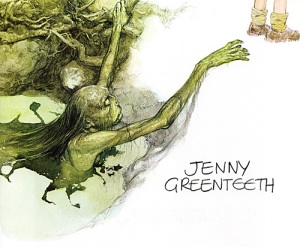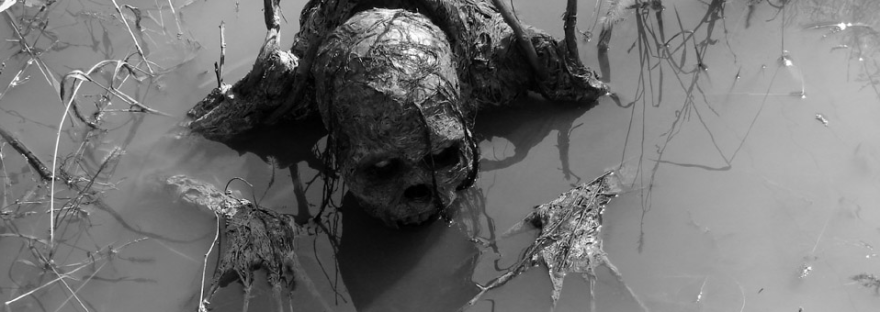I recently published a horror story called Greenteeth, which was inspired and heavily influenced by the folklore of Jenny Greenteeth. Do you know what Jenny Greenteeth is? No? Then you’ve come to the right place.
Who is Jenny Greenteeth?
Jenny Greenteeth is a monstrous creature from the English folklore of Lancashire, Cheshire and Shropshire, though she also appears in other parts of the British Isles under different names such as Peg Powler, Kelpie or Grindylow.
In keeping with the tradition of the bogeyman, Jenny (also sometimes Jinny Greenteeth or Ginny Greenteeth) has been created in order to scare children into behaving in a certain way – in this case keeping them from playing close to lakes and ponds in case they fall in and drown.
“If you stray too close to the slick mud bank of the pond then out of the black water a ragged hand will come, and its clawed fingers will close around your ankle and it will haul you in. You’ll struggle and fight but its grip is like cold iron, and it will drag you down into the darkness beneath the lilies and it will hold you there among their tangled stems until the last breath slips from your lungs. So be sure never to play near the edge of the water, child. Be sure never to get close enough that old Jenny Green Teeth can pull you in.”
That kind of thing is obviously going to be much more effective than “don’t play by the pond, you might fall in and drown”.
Today our diminished fear of drowning means that this kind of gruesome warning may seem over the top, but it makes more sense when it is placed into a historical context.
The historical context: drowning in England
Drowning was until relatively recently a very common way to die in England. Historical research into coroners’ reports by Dr Steven Gunn and Dr Tomasz Gromelski (listen to their podcast “Accidental Death in Tudor England”) shows that between 1558 and 1560 nearly half of all accidental deaths were drownings; for context, in 2010 the equivalent figure was less than one in fifty.
Why is this?
In the past, without indoor plumbing and the modern amenities that we take for granted, people’s lives were connected more intimately with bodies of water. Water was used as a source of power – for grinding wheat, for example – and as a way to launder clothing. People would ride their horses into water in order to wash them. Water transport was cheaper than road transport, which, combined with the simple fact that there were fewer bridges, meant that people relied on boats far more than they do today – and boats would often capsize.
Few people could swim, however, and in water the clothing of the time – spun from thick, absorbent materials such as wool – would hamper movement and become extremely heavy.
All of this added up to make water a serious danger. So it’s pretty obvious that if you’re living in, on and around water and you know that falling in is typically fatal, you’re going to instill in children the idea that water is dangerous.
And what better way to do that than with a monster?
Interpretations of Jenny Greenteeth
Folklore describes Jenny Greenteeth as a water hag with green skin, long hair, long grasping arms and needle teeth, (though the broadly equivalent Bean Fionn of Irish mythology is described as being a water fairy dressed in white – “Bean Fionn” translates literally as “white woman”). With this description in mind it’s pretty clear that the character of Meg Mucklebones in the 1980s film Legend (starring a pre-expensive-dental-work-and-Scientology Tom Cruise) is inspired by this lore.
One of my favourite images is by the artist Brian Froud. I think it’s the fractured duckweed on the surface (Jenny Greenteeth is closely associated with duckweed) and the slick green hair sliding over the creature’s shoulders and

into the water that does it for me. The warning of drowning may be fairly abstract for a child, but I imagine it’s not too much of a stretch for a child to believe that a tangled mat of pond weeds is the hair of a monster lurking silently beneath the surface waiting to reach up and pull you in. This picture sums that up better than any other, I think.
The other imagery that really caught my eye when I was doing research for this story was the series of Hallowe’en photographs at pumpkinrot.com. There is a whole set of photographs of Jenny Greenteeth from Hallowe’en 2010, and I thought they were so well done and so gruesome that I requested the use of one for the story’s cover image – and Mr Rot was kind enough to grant me permission to use the image that I’ve used as the feature image at the top of this post.
